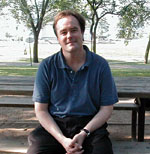By Dan Olson
Minnesota Public Radio
July 22, 2002
Finding room for nearly one million more Twin Cities residents is one of the controversial items on the Metropolitan Council's agenda this year. Projections show the region's population will grow by more than 900,000 people over the next 30 years. State Sen. Myron Orfield, DFL-Minneapolis, wants the Metropolitan Council to adopt a plan that will more tightly control the sprawl.
| |
|
|
|
||
We're no Las Vegas, the country's fastest growing city. However the Twin Cities' population increase the past decade was 16 percent, one of the highest rates in the Midwest. Finding room for a projected 930,000 more people by 2030, Myron Orfield says, is a huge and historic challenge. Orfield is author of the new book, American Metropolitics, the New Suburban Reality.
Unbounded by oceans and mountains, the Twin Cities are surrounded by wide open space. Orfield says it's a sprawling metropolis with a higher than average rate of elbow room. He says the Twin Cities metropolitan area is one-third the size of Chicago, and sits on two-thirds as much land, "and we have a proposal now before the Metropolitan Council to add 20 percent or more to that land area."
The additional services - the roads, sewers, water and schools - will cost tens of billions of dollars.
Orfield is a Minnesota state senator not seeking another term, who has carved out metropolitan growth as his expertise. The Minneapolis-based company he founded is hired by cities around the country to analyze their growth patterns. Nationally-syndicated columnist Neil Pierce has called Orfield the country's most influential metropolitan demographer.
Orfield says one way to save money and manage sprawl is to limit the amount of land available for development.
"A person like me thinks if we're the third-lowest density region in the country and have lots of open land in the urban service area, we ought to fill that up," he says.
Metropolitan Council officials agree, and say their plan for accommodating growth over the next three decades encourages filling in open spaces in existing cities. However, many Twin Cities communities discourage denser development. Some have zoning codes requiring large lots and houses with multiple car garages.
People who can't afford luxury homes but who still want their piece of paradise flock to the fringe - small towns at the edge of the Twin Cities metropolitan area where space and housing aren't quite as expensive. Census numbers show the explosive result - fast-growing towns which have a difficult time supplying the services demanded by new residents.
Orfield says the towns, "have a very high ratio of kids to households. They're never developing the commercial or industrial tax base that they need to adequately support schools, roads, public infrastructure, sewer systems."
The stereotype that all suburbs are alike, Orfield says, is a myth. Mature inner-ring suburbs face decay once only associated with central cities. They need redevelopment. Bedroom suburbs like Woodbury and Apple Valley are struggling to manage growth. A smaller number of affluent suburbs with a healthy tax base supported by luxury homes and thriving businesses want no additional development. Trying to win agreement on how to control sprawl from those disparate points of view is difficult.
Orfield says there may be a way to build a political consensus by appealing to taxpayers in affluent suburbs and edge cities who want to preserve their version of Eden.
"Do we - and do they - want to send another 150,000 or 200,000 people from the cities and inner-ring suburbs, to surround and make their area as urban as the one they left? I think there may be some support out there for keeping all of us here, so they can keep the idyllic nature of what's going on at the edge," Orfield says.
Will there really be one million more Twin Citians in 30 years? Skeptics, including demographers, say estimating population trends three decades into the future is highly speculative. Metropolitan Council officials say it's wiser to plan for that many new residents than ignore the possibility.
Meetings and public hearings on a Metropolitan Council growth plan continue through the summer and fall, with adoption of a plan set for December.
More Information
